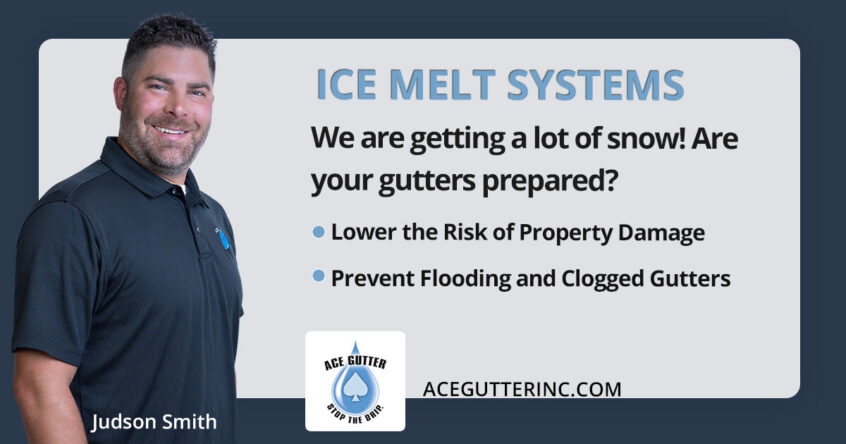There’s something undeniably magical about icicles hanging off the edge of a snow-covered roof. They are common, beautiful, and make you stare in awe.
But here’s a little-known fact about icicles, they’re almost always a sign that your roofing system isn’t working. The same conditions that create icicles can cause a much bigger problem known as ice dams.
An ice dam is a buildup of ice near the edge of your roof that prevents melting snow from properly draining off. If left untouched, it can rip off gutters, damage shingles, and cause incessant water leaks. This, in turn, may lead to a whole new list of problems, including peeling paint and mold.
Fortunately, there are ways to nip ice dams in the bud, provided you can spot the warning signs.
How to Spot an Ice Dam on Your Roof
Identifying ice dams should be your primary concern when you inspect your roof over the winter. In case you don’t know where you start, here are five warning signs to look out for.
1. Water Leaks
Since ice dams inhibit normal drainage, they can force water back into your roof and home. Hence, if you’re seeing any new water stains on your ceiling during winter, it’s likely due to an ice dam. Large ice dams can also create active dripping leaks, usually on the uppermost floors of your home. Even on the lower floors, water can run down the inside of the walls and pour into the basement. It’s an incredibly dangerous situation that should be dealt with immediately. Otherwise, you could be looking at:
- Disintegration
- Termite infestations
- Plaster crumbles
- Electrical damage
- Decaying windows and doors
- Mold problems
- Health issues
We recommend you investigate any ceiling/wall stains as quickly as possible. The sooner you call a contractor, the more damage you can prevent. Or, you can sidestep the problem right out the gate by investing in commercial heat tape for gutters.
2. Hot Spots
Have you ever wondered why some spots on your roof are bare when the rest is covered in snow? You’re probably looking at hot spots.
Generally speaking, hot spots indicate that heat is escaping your home through certain areas around the roof (such as the vents and skylights), causing the snow to melt only in those places while the rest remains intact.
But why are hot spots a problem?
A well-insulated attic has one critical job in the winter- to keep the heat inside your home. Simply put, the insulation ensures that the air inside your home doesn’t dissipate outside. Hence, hot spots may indicate that your roof insulation is wearing out. This can lead to a steep spike in your heating bills.
Additionally, hot spots are a sign your roof is at high risk of ice damming. The melted snow runs down the roof and refreezes (usually over the eaves), making contact with the deck. Because this part of the roof is unexposed to heat, the snow accumulates and forms ice dams.
3. Icicles
As pretty as they are, icicles are bad news for your roof. They occur when your gutters are full of ice and unable to move water away. Once the ice builds, it backs up onto your roof and eventually pushes water into your home.
Assess the appearance of icicles on your roof. Do they hang from the shingles or the gutter troughs? Also, do they resemble a wave coming over the edge of your roof? If so, chances are they are connected to a larger ice structure.
4. Ice on the Exterior Walls of Your Home
Like us, you’re probably not used to seeing snow on the outer walls of your home. But when this happens, you must take action immediately.
Ice on the exterior walls, beneath the siding, behind the soffit, or in other odd places may point towards an ice dam. Water traveling back from the roof eaves can seep behind surfaces and refreeze, showing up as water stains during summer.
Needless to say, your house shouldn’t have ice on the walls. Call a professional roofing contractor as quickly as possible to take care of the situation.
5. Visible Dams
Most large ice dams appear as large hills or mounds of ice along the bottom edge of your roof. You couldn’t miss them!
But there’s a catch: smaller ice dams on higher or steeper roofs may be hard to spot. Some even form over skylights or in roof pan areas, which aren’t visible from the ground. Here, you might have to get a closer view of your roof to identify ice dams before they cause damage.
However, if you cannot inspect the roof, or feel uncomfortable with the prospect, contact a contractor to identify any potential issues for you.
How to Deal with Ice Damming
Once you confirm an ice dam problem, it’s time to get rid of them for good. We’ll walk you through a few ways to do this, as well as an effective preventative measure to keep your roofs dam-free.
1. Rake Your Snow
Use a little elbow grease to remove snow from your roof before it can melt. This little manual labor is a small price to maintain your roof’s condition throughout the winter. Be careful to use a rake made specifically for snow, and to not damage any shingles in the process.
2. Use Calcium Chloride
Ice dam melters like calcium chloride can help de-ice your roof after ice damming. However, do use it with caution. Remember to wear Personal Protection Equipment and keep the chemical away from plants growing under your gutters.
3. Use Heated Cables
Few things prevent ice dam formation like heated cables and similar ice melt roof systems. Roof heat tape installation is the way to go if you’re looking for a more permanent solution to ice dam formation.
The Bottom Line
There you have it: five signs you have ice dams on your roof!
Since ice dams are a potent threat to the integrity of your roof, you must handle them without delay. Hopefully, this post has helped you understand how to identify ice damming, and a few ways to solve the problem post-haste.
That said, the best way to get rid of ice dams is to ensure they never happen. That’s where Ace Gutter’s ice dam melting systems can come to your aid! Our unique heated roof panel systems are elegantly designed to protect your home and increase curb appeal. For more information, feel free to reach out to us today!


